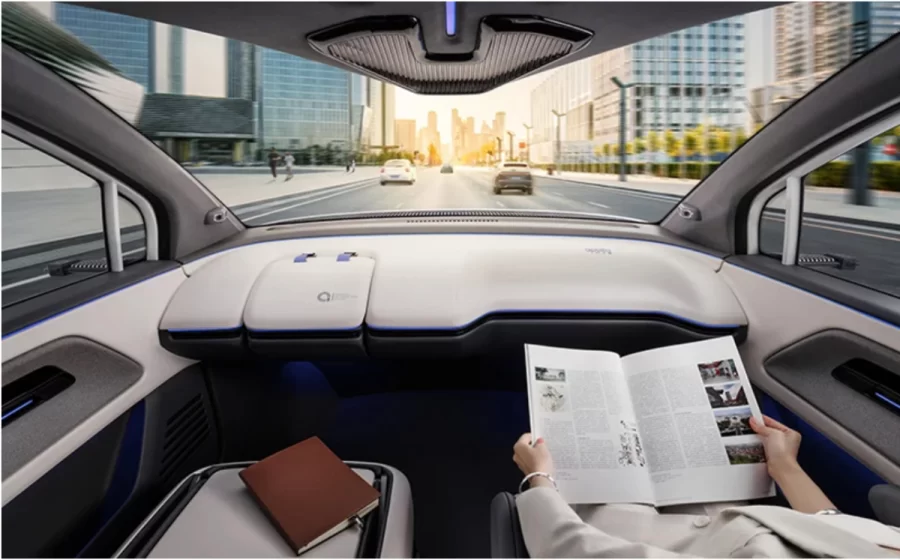Autonomous cars could provide safe and reliable transport for everyone
Self-Driving Cars
The (potential) future of transportation
October 25, 2022
As humanity continues to move towards the future, we continue to make massive advancements in transportation and in our individual modes of transport. In recent years, a new technology has begun to emerge, one that has the capabilities to revolutionize the way that humans get from Point A to Point B – autonomous cars.
An autonomous car, also known as a self-driving car, is defined as a “vehicle capable of sensing its environment and operating without human involvement. A human passenger is not required to take control of the vehicle at any time, nor is a human passenger required to be present in the vehicle at all. An autonomous car can go anywhere a traditional car goes and do everything that an experienced human driver does” (From synopsys.com).
Previously existing in science fiction alone, autonomous cars are now becoming a reality. According to the Department of Transportation, this new technology provides a safe, reliable, and efficient way of transport. Nearly 94% of crashes that occur in the United States are a result of human error. Driverless cars could negate these factors and greatly improve driver safety and accessibility.
Many car manufacturers, including Ford, BMW, and Tesla, have already begun to implement this new technology. Waymo, a Google self-driving car project that began in 2009, has taken the lead in advancing fully-automated vehicle technology. Their goal is to make mobility easy and accessible for everyone. The elderly, disabled, and others unable to drive themselves would have access to a simple way of traveling and being able to “do the things they love.” The technology that powers these autonomous cars includes “lidar, cameras, radar, and a powerful AI compute platform.” These fully-automated cars, which require no input nor human monitoring, are not yet available to the public. They are still undergoing testing in many parts of the world. Any and all weaknesses that are found are analyzed and improved. The technology behind the wheel is constantly improving.
Tens of billions of miles – simulated and real world – have been driven by Waymo’s vehicles in order to teach and upgrade the car’s intelligence system. Thousands of closed-course scenarios have been staged to test the car’s capabilities and reactions to unexpected situations that could occur on the road.
However, many issues regarding self-driving cars must still be solved before they can hit the roads. One of the more prevalent discussions about autonomous cars concerns liability. If an autonomous vehicle were to crash, who would be held liable? The passenger in the car? Or the company itself? Cyberattacks are another threat to autonomous cars, with each car being powered by roughly triple the amount of code that modern-day cars have. The high-definition maps that autonomous cars create and use could be compromised, and the detailed information it holds about American towns and cities could potentially fall into the hands of American adversaries. In a similar vein, the cameras located around the car necessary for the car’s function brings up the controversial topic of mass surveillance, impeding on the peoples’ right to privacy.
Moral concerns are another ongoing debate. A popular ethical dilemma commonly known as “the trolley problem” involves an individual choice between the lesser of two evils. Within this hypothetical situation, a trolley is heading down railroad tracks, on course to run over three people. The individual in question has the option of pulling a lever, diverting the trolley and forcing it to run over only one person instead. In the event of a real unavoidable crash, it is still uncertain how a program within an autonomous vehicle would react in the split-second decision; would it prioritize the safety of its passengers, or would it sacrifice the lives of its passengers to save a greater number of people?
A form of vehicle autonomy known as “driver-assisted” systems are already available to the public. Tesla’s Autopilot mode allows the vehicle itself to “steer, accelerate and brake automatically within its lane.” However, these systems still require the drivers to be alert and prepared to take control of the vehicle in certain situations. Unfortunately, systems such as these can often lull drivers into a false sense of security and can result in their complete relinquishment of the vehicle’s control. Of the two hundred and seventy-three crashes involving Tesla’s Autopilot and other subsequent autonomous systems reported by The New York Times, five of them were fatal.
We must proceed cautiously with this new technology. We need to ensure that these cars are just as capable as a skilled human driver and will respond to unexpected situations correctly. However, if handled properly, autonomous cars could not only benefit the United States, but the world as a whole.


